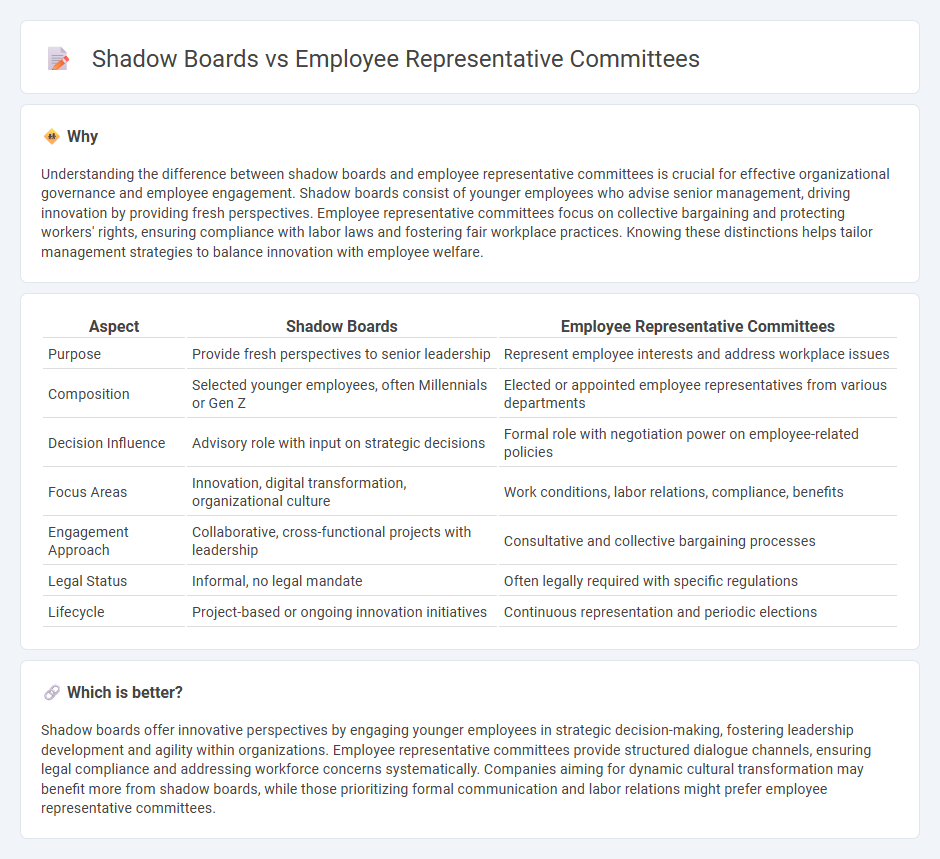
Shadow boards consist of younger employees who provide fresh insights directly to senior management, fostering innovation and bridging generational gaps. Employee representative committees typically focus on advocating for workers' rights and facilitating communication between staff and management to ensure fair treatment. Explore the distinctions and strategic benefits of shadow boards versus employee representative committees to enhance organizational management.
Why it is important
Understanding the difference between shadow boards and employee representative committees is crucial for effective organizational governance and employee engagement. Shadow boards consist of younger employees who advise senior management, driving innovation by providing fresh perspectives. Employee representative committees focus on collective bargaining and protecting workers' rights, ensuring compliance with labor laws and fostering fair workplace practices. Knowing these distinctions helps tailor management strategies to balance innovation with employee welfare.
Comparison Table
| Aspect | Shadow Boards | Employee Representative Committees |
|---|---|---|
| Purpose | Provide fresh perspectives to senior leadership | Represent employee interests and address workplace issues |
| Composition | Selected younger employees, often Millennials or Gen Z | Elected or appointed employee representatives from various departments |
| Decision Influence | Advisory role with input on strategic decisions | Formal role with negotiation power on employee-related policies |
| Focus Areas | Innovation, digital transformation, organizational culture | Work conditions, labor relations, compliance, benefits |
| Engagement Approach | Collaborative, cross-functional projects with leadership | Consultative and collective bargaining processes |
| Legal Status | Informal, no legal mandate | Often legally required with specific regulations |
| Lifecycle | Project-based or ongoing innovation initiatives | Continuous representation and periodic elections |
Which is better?
Shadow boards offer innovative perspectives by engaging younger employees in strategic decision-making, fostering leadership development and agility within organizations. Employee representative committees provide structured dialogue channels, ensuring legal compliance and addressing workforce concerns systematically. Companies aiming for dynamic cultural transformation may benefit more from shadow boards, while those prioritizing formal communication and labor relations might prefer employee representative committees.
Connection
Shadow boards and employee representative committees both serve as platforms for employee involvement in organizational decision-making, enhancing management transparency and inclusivity. Shadow boards consist of younger or emerging employees who provide fresh perspectives to senior executives, while employee representative committees formally advocate workers' interests and ensure compliance with labor regulations. Both structures foster communication between management and staff, contributing to improved workplace culture and more informed strategic decisions.
Key Terms
Employee Voice
Employee representative committees serve as formal channels within organizations for employees to voice concerns, influencing policies and workplace conditions through structured dialogue. Shadow boards consist of younger or diverse employees who provide strategic input directly to senior management, emphasizing innovative perspectives and employee engagement at an organizational level. Explore how integrating these approaches can enhance effective employee voice and drive organizational success.
Decision-Making Influence
Employee representative committees serve as formal bodies advocating worker interests, often participating in consultations and providing feedback on company policies. Shadow boards, composed typically of younger employees or diverse talent pools, act as strategic advisors influencing high-level decisions and innovation by offering fresh perspectives aligned with market trends. Discover how these mechanisms differ in driving decision-making influence within organizations.
Organizational Change
Employee representative committees facilitate organizational change by providing a structured platform for employee input, promoting transparency and trust within the company. Shadow boards consist of emerging leaders who simulate executive decision-making, fostering innovative perspectives and accelerating change initiatives. Discover how these mechanisms can drive effective transformation in your organization.
Source and External Links
Occupational Health & Safety Committees and Representatives - Works to create a healthy and safe work environment through employer and worker collaboration.
Understanding Employee Representation & Consultations - Involves various types of employee representation, including unions, workers' councils, and employee committees.
Everything you need to know about employee engagement committee - Focuses on enhancing employee engagement through diverse representation and workplace initiatives.
 dowidth.com
dowidth.com